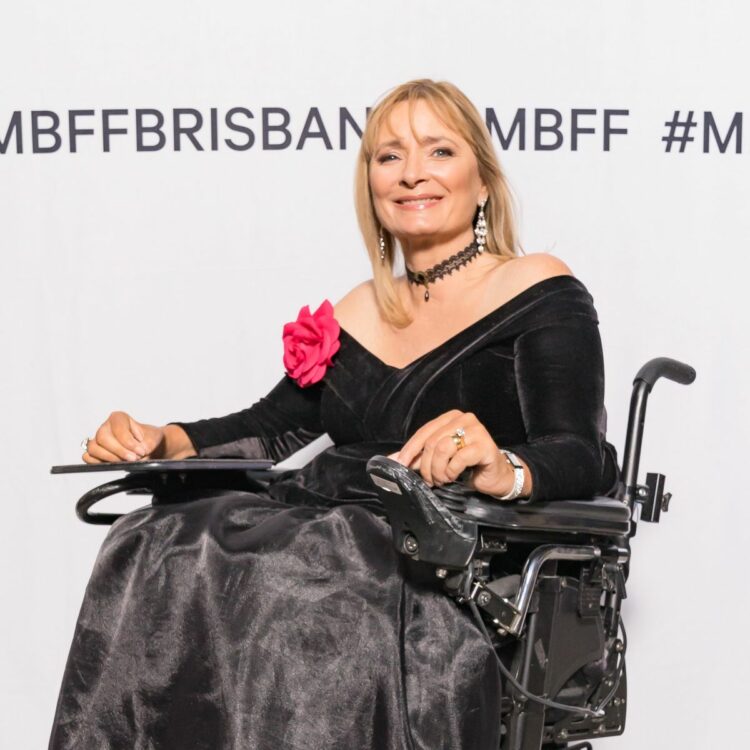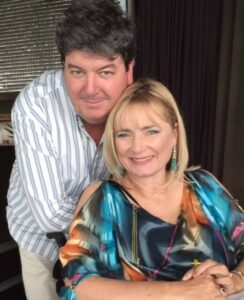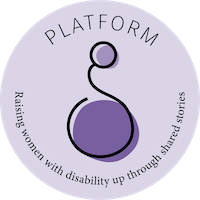Banner image credit: Richard Smith
I first realised that fashion and disability did not necessarily easily go together, when, as a fifteen year old girl with a spinal injury, and desperately longing to get out of the track suits and soft fabrics which were de rigueur in the rehabilitation hospital – the uniform of those learning to live and function in a totally new way, I realised that clothes; something I had always taken for granted, were not all they seemed.
At first, I denied that fashion mattered to me. I had so much else to learn, to navigate in this new world of disability that it seemed irrelevant, but as I matured and learned more about myself and what mattered, I realised that it did matter. Clothes make statements about who we are, and I definitely had my own identity. It was frustrating to always have to navigate fashion around how it “fit” or “looked” on my body, and how it would function as I navigated the world from a sitting position. Imagine having to consider things like a prosthetic, scoliosis, hidden disabilities, a colostomy bag or temperature imbalances in every decision you make about what you wear. This is the life of those with disabilities. This type of censoring is tiring and definitely does not help positive body image.
Fortunately, times are changing. We now have much more wonderful representation in the fashion industry, we are seeing disabled women starting to confront fashion stereotypes by wearing what they want, how they want, and taking part in or creating their own fashion shows, as well as working with designers to adapt clothing to fit all bodies. We have disability fashion influencers, breaking stereotypes and showing us that we all deserve to feel a part of fashion and represented in an industry that has such an influence on who we are and how we feel.
This Platform Story is about one woman’s journey with disability and her response to fashion frustration – let me introduce you to Carol Taylor…
Tell us about yourself:
I am a lawyer, artist, fashion designer and disability advocate by day and a wife and mum 24/7. I am also a quadriplegic paralysed from the chest down and with completely paralysed hands. I live in Tallebudgera Valley on the Gold Coast hinterland on 10 acres with my husband, son and a menagerie of crazy animals including 2 German shepherds, 2 toy poodles, 3 cats, 3 horses and a talking sulphur crested cockatoo called Charlie.
What has been your journey to disability?
In 2001 I was a relative newlywed with a thriving legal practice in Sydney and hoping to start a family, life was good. However a life changing event occurred on 9 July 2001. As my husband Rob and I were travelling home early in the morning after a weekend away in the Blue Mountains we hit black ice and our four-wheel-drive rolled. On the second roll the roof of the car caved in and hit me on the back of the neck severing my spinal cord instantly at the C5/6 level. Initially I was paralysed from the neck down. In that split-second my life was forever changed. Despite all the chaos going on around me, my husband flagging down a truck, a helicopter landing in the middle-of-the-road to airlift me to hospital, the thought foremost in my mind was whether or not I would still be able to have a child. I was placed on life support and spent the better part a year in hospital undergoing months and months of endless physio and occupational therapy. Thankfully I recovered some arm movement although my hands and fingers are still paralysed. It was an exhausting triumph when I was first able to lift an empty Styrofoam cup without help.
I was determined to maximise my strength and I spent many long, frustrating hours in the gym and with the occupational therapist using a special splint to thread beads onto a string. The result of all that hard work is that with the help of an extremely strong right shoulder I am now able to write. Remarkably, my writing is better now than it was before the accident!
In that split-second my life was forever changed.
Fortunately for me I have an incredibly supportive husband which gave me the strength to keep fighting every step of the way. For a long time after my accident I was unable to speak, my sister and husband would hold up felt letters of the alphabet and I would blink to spell words out to enable me to communicate. When I finally could speak my first question to the doctor was whether or not I could carry a child and I was told no it wouldn’t be possible because of complications to my heart. My second question was to ask my husband for a divorce, thankfully for me he also said no. On 12 September 2001 it was our 3rd wedding anniversary; it was also the day that I was to sit in a wheelchair for the first time. Rob wheeled me into a cafe within the hospital grounds. The cafe had a small courtyard and unknown to me my parents and a priest were waiting. As Rob wheeled me into the courtyard the music that played in the church on our wedding day bellowed through the hospital speakers. In a very emotional ceremony with Robert on bended knee we renewed our wedding vows. In America the date was September 11, and for a short while at least, there was some relief from the ghastly images on the TV.
On 12 September 2001 it was our 3rd wedding anniversary; it was also the day that I was to sit in a wheelchair for the first time.
The next four years were the hardest as I found it very difficult to adjust to my new life as a quadriplegic. When I came home from hospital I was very depressed. It was always the littlest things that would catch me off guard and spiral me into a heap. I recall vividly the moment Rob opened our front door, the same door he carried me through as his bride only three years earlier.
The sun beamed onto the tiny dents all over our hallway floorboards highlighting my years of devotion to stiletto high heeled shoes, shoes I knew I would never again be able to wear. Without a doubt the most devastating blow was the knowledge that I would not be able to carry a child to full term. We knew that we had to find a distraction, something to help me cope and once again, Robert to the rescue.
I spiraled into a very deep depression and suffered acute PTSD. Robert decided that what I needed was an outlet for my creative spirit. He arrived home one afternoon with a set of paint brushes in one hand and a completed enrolment form for art classes at the local community college in the other. I attended one class and was treated terribly by the instructor. At that time it was necessary for me to wear a splint on my right arm to enable me to hold a paint brush so I guess between that and the wheelchair I must’ve looked a bit of a fright! The other students in the class avoided any attempt I made at eye contact.
Sometimes, when people don’t know what to do, they do nothing, they mean no harm by it. The instructor wouldn’t look at me, she spoke to Robert, it was as if I wasn’t even there, I felt like his child – ultimately she recommended that perhaps I might be more suited to an abstract style art where I could learn a sort of splashing technique. Needless to say I came home in tears and never returned for the remaining classes.
I found a way to draw, to paint, and to create.
With Rob’s support I was determined to find and embrace the beauty in life. I spent years teaching myself with the help of Rob’s makeshift modifications to brushes. I found a way to draw, to paint, and to create. Initially I was concentrating on oils before being seduced by the translucency of watercolours. Acclaimed artist, mentor and dear friend Maryanne Holmes was instrumental in aiding me to continue on my artistic journey.
Art became a form of therapy, a way to cope with the enormous life changes with which I was faced. Art became my yoga. I went on to study under other noted watercolourists such as John Lovett, Greg Allen and Robert Wade. I now sell my art, and have auctioned it for MS and spinal cure research (PCSRF) and have won art prizes. I am member of the Watercolour Society of Queensland and the Royal Queensland Art Society.
Can you share with us your journey of motherhood?
Though art helped me cope, Robert and I never give up hope of one day having a family. Despite 8 years of IVF and a total of 15 embryo transfers each pregnancy only resulted in miscarriage. In 2005 when we moved to the Gold Coast hinterland we sought the help of a naturopath. In our minds it was one last very desperate attempt, however one month later we were pregnant the old fashioned way. I spent a total of 5 months in bed in order to keep my baby until the big day.
Robert and I never give up hope of one day having a family
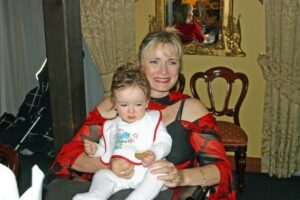
All the worry of which melted away on the 3 November 2006 when our little miracle son D’arcy was born. I had a wonderful delivery but was unfortunate enough to contract a life threatening infection as a result of an epidural abscess in the spine. It took three weeks of intensive treatment by infectious disease specialists and a neurosurgeon, but we were finally able to leave hospital and come home as a family, albeit as a very sick mummy with two months intravenous antibiotics ahead of me.
D’arcy is now 13 years old and I am so proud of the man he is becoming. Parenting with quadriplegia presents very considerable challenges, however being a mum is the best job I have ever had, and it’s also the most challenging and the most rewarding.
What do you do for a living?
With D’arcy’s increasing independence over the years I missed the intellectual stimulation of my former career and to a lesser extent the sense of professional identity which was lost as a result of my accident. I briefly considered the idea of looking for part time work with a law firm.
I imagined my desire for flexibility coupled with my disability would not be a package met with open arms by any prospective employer. So I decided to set up my own practice. I wanted to ensure I had complete flexibility to sustain work life balance. Having waited so long and having endured so much to have a family my concern was that an employment situation may not cater to my needs. Being disabled, I am naturally drawn to technology to assist in my day to day activities.
In 2014 my husband brought to my intention the incredible advancements in technology by a company called PEXA (property exchange Australia). This technology was the catalyst for my return to the workforce. The technology has completely revolutionised the way in which property transfers occur throughout Australia. I saw an opportunity despite my disability and PEXA with the catalyst for my return to the workforce. In 2015 I established Taylor Law & Conveyancing and we made history by becoming the first law firm in the State of Queensland to conduct an electronic simultaneous on-line settlement between two properties 1200 km apart! We practice in what I like to call “wheelchair friendly” law, predominantly property law, Wills and Deceased Estates. For obvious reasons I have a personal interest in human rights and anti–discrimination, disability law and policy.
I saw an opportunity despite my disability
Can you tell us about MeQ Designs?
In November 2018 I was fortunate enough to win the QLD Access Arts Achievement Award. This was a $10,000 Award. For far too long people with disability have been left out of the fashion conversation and I want to change that. My concept for the Award was to place my own artwork on fabric and to create adapted fashion designs for people with disability. To my knowledge I am the world’s only quadriplegic designer designing for other quadriplegics and people with disability. After winning the Award that’s exactly what I did. I started with 4 waistcoats for a black-tie dinner event. I approached the 4 guest speakers and asked whether I could design their waistcoats. I warned them that my artwork was very colourful however they were happy for me to proceed. As a result of winning the Access Arts Achievement Award some of the organisers came to visit me and over the course of conversation I explained that over the last 18 years as a quadriplegic I had designed many garments for myself, in particular evening wear. One thing led to another the next thing I knew half of my wardrobe was on exhibition at Artisan Brisbane for 2 months.
Shortly after, I received a call from the Director of the Mercedes-Benz fashion Festival and I was asked whether I would like to design a collection of 9 pieces to open a runway event for the Mercedes-Benz Fashion Festival. I immediately agreed as this was too wonderful and opportunity to shine a spotlight on such an important issue. I understand that most of the designers have at least 1 year to design their collection, I had 12 weeks! I needed a name for my collection, when I go shopping I want to scream “me too!” and so I came up with the name MeQ Designs, the “Q” of course representing me the Quad.
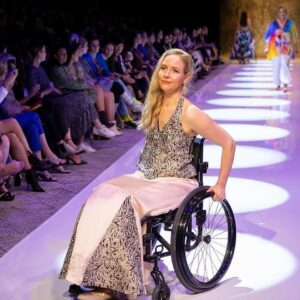
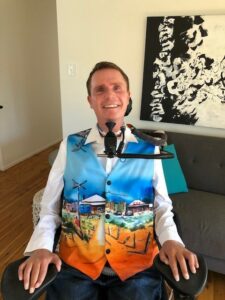
image credits: Richard Smith
Can you tell us in detail about the adaptations you made to garments you design?
As a quadriplegic there are many complications that one faces when wearing shop bought clothing. Blood circulation is a real issue. This means that an ill placed seam or a zip in the wrong spot which presses against the flesh can cause a pressure sore. Pressure sores are a constant worry for anyone that is in a wheelchair as it is very easy to become hospitalised for many months. One of the other issues many people with disability face is something called autonomic dysreflexia.
Essentially this means that my body reacts to stimulus in an erratic way so one of the daily complications I have to deal with is temperature control. Even though I live in tropical Gold Coast Queensland my husband lights the fire at 5:30 AM as the thermostat in my brain which controls my body temperature no longer works properly. I can’t shiver to warm my body nor can I sweat properly to cool my body down. I start the day out wearing thermal clothing to be warm. As the day progresses and the temperature rises my blood pressure behaves erratically. Once the climate is warm my blood pressure drops suddenly and without warning and I faint. The flipside is that sometimes stimulus can cause my blood pressure to rise rapidly which can put me at risk of a stroke. For years I would carry a change of clothes in the car so that if suddenly the day got hot I could find somewhere to change into something cooler.
This became cumbersome and required easy access to the car which was not always possible. I designed my caftans so that they have a secret little pocket within themselves so that the caftan can essentially fold within itself into a drawstring bag contained in the front panel of the caftan. Once the caftan is folded on itself and into the drawstring bag it is then very easy to fit into my backpack which lives on the back of my wheelchair and so I am ready to do a quick change should there be a change in temperature.
There is another feature of my caftans that was born out of necessity. Like most quadriplegics in order to retain heat I am drawn to the sun to soak up its warmth, a bit like a cold-blooded lizard. Once I have my 15 to 20 minutes then my batteries are charged and I’m set for the day. The result of this continued sun exposure was that I have very brown forearms. I was worried about the potential health risk of too much sun exposure. I attempted to solve the problem by bringing a pashmina with me to cover my forearms but sometimes I would forget to bring it. So I designed a feature of my caftans so that they have a secret little sleeve panel that can be pulled on to release an extension of the sleeve. It is hidden near the shoulder/bra strap area and held with a press stud. The additional sleeve panel drops down below the usual sleeve length and has a little loop that slips over my middle finger now providing complete protection from the sun and preventing my arms from premature ageing and the risk of skin cancer. As the day cools down this little sleeve lapel easily clicks back into place on my shoulder and returns to normal looking caftan. This is not only ideal for someone with temperature control issues as a result of a disability, anyone could benefit from having something like this to easily throw into their beach bag.
With my evening wear designs I have replaced ordinary zips with invisible zips and magnetic zips. I reached out to a company called Mag Zip in America and they were nice enough to sponsor my collection. They sent me an assortment of different zips and I use them in my collection. The zips are usually used by Under Armour for skiwear and have an industrial look to them, however I decided to mix up this industrial look with eveningwear fabrics. The beauty of using a magnetic zip is that someone with hand dexterity issues no longer has to struggle with trying to line up one side of the zip with the other. The magnetic zip simply clasps together and is easy for an amputee or potential stroke victim to operate. They have so much appeal even for someone with arthritis. I also replaced buttons with magnets which were sewn into the fabric.
One of the other features to be taken into account with the evening wear and wheelchairs is the fact that shop bought evening gowns are the same length at the back as they are at the front. All this excess fabric presents a dilemma when you are in a wheelchair as the fabric gets caught in the wheels. My evening dresses were designed to have less fabric at the back and are shaped to avoid collision with the front wheels. One of my evening dresses is what I call a “smoke and mirror” design as I cannot sit on fabric that moves, the risk of pressure sore is too high so I have designed the evening dress around my wheelchair but for all the world looks as though I am wearing a full evening gown.
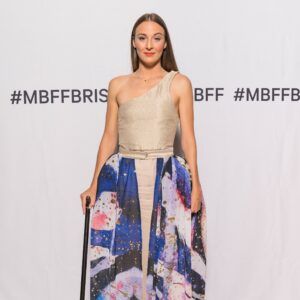
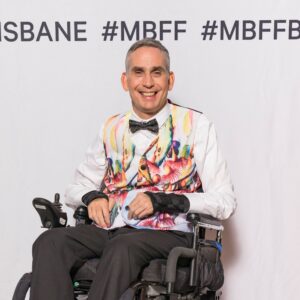
image credit: Richard Smith
What are the most difficult things about getting dressed when you are in a wheelchair?
For me the most difficult thing about getting dressed is the fact that I cannot stand at all. I am a complete quadriplegic. Some people with spinal cord injury and other disabilities have the ability to stand just long enough to pull a skirt up over their bottom. I do not have this ability so I am dressed by rolling in my bed from left to right. This works fine for pants but is really impossible for a skirt or dress as by the time I transfer into my wheelchair the back of the garment is all caught up underneath my thighs and bottom and is a definite risk for pressure sores. The other important issue is that I need help with dressing so in order to get a top on over my elbows and shoulders etc I need to buy clothing a size or two bigger than my actual size just so someone can get it on easily.
Of course by the time the item is over my head and over my arms and elbows and finally on, the garment clearly looks ridiculous on me as it is so oversized. This was really obvious when I was designing the waistcoat for one of my male models. I took a before photo of him wearing a shop bought waistcoat which just looked so oversized by the time he got it on. I designed a waistcoat using fabric with my own artwork to fit him and used an invisible zip and magnets to make it easy to dress without being oversized. The greatest difficulty with shop bought clothing for most people in the permanently seated position is that clothing is designed for someone that is standing up.
When you are in a permanently seated position your body over time acquires a different shape, more like an “A” frame shape and my collection was designed to cater to this shape. Most people in wheelchairs experience muscle atrophy which results in muscle slowly dropping and eventually landing unceremoniously on your lap, most quadriplegics refer to this as their “quad pod”. I design my clothing to work around my quad pod so that it is less noticeable.
Is fabric selection important in adaptive collection? Which fabric works best?
Fabric selection is important. For the caftan that folds into a drawstring bag the fabric needs to be of a type that doesn’t wrinkle easily. I chose a polyester blend. For eveningwear, I like to try different fabrics but my personal favourite and the fabric which I believe is most forgiving around the problem tummy area is velvet.
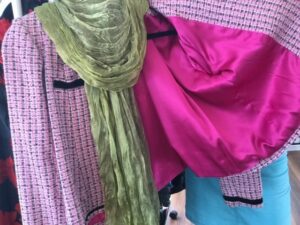
Is more fabric required to make your clothes?
No, in many cases, particularly with eveningwear I use less fabric as I am deliberately trying to avoid excess fabric coming into contact with the wheels of the chair.
What is your favourite piece in the collection?
I think my favourite evening piece would have to be the black and pink ballgown worn by my beautiful model Bella Herrmann. I designed this gown specifically to showcase Bella’s prosthetic leg. Bella was born without a tibia and was amputated from the thigh when she was only 17 months old. She is quite rightly very proud of her prosthetic leg. This fabric like many in my collection features my own artwork printed onto fabric. Duchess Satin was used for the skirt overlay with my artwork underneath as the lining.
The waterfall effect at the front of the gown reveals my artwork as the fabric falls. This gown is a two for one deal. The skirt overlay can be easily removed to reveal a fitted black velvet cocktail number complete with magnetic zip for ease of dressing. The transformation from cocktail dress to ballgown has never been easier. My favourite daytime piece is my caftan as it is so versatile, it immediately gives me the freedom to change of clothes anytime anywhere and offers me the added protection I need from the sun on an as needs basis.
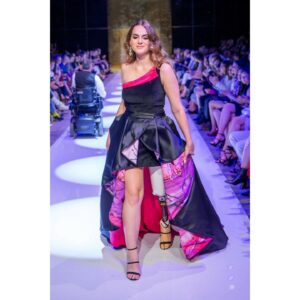
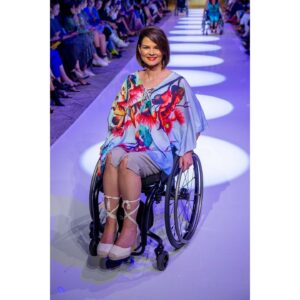
Image credit Richard Smith
After the success of your collection at the festival I you considering creating your own line?
I would love to create my own label, I have since then the recipient of a small business digital grant and put in the wheels in motion to launch a small online collection. I have already had so many inquiries from people asking when will my clothing be available. Ideally I think it would make sense to either have an experienced mentor or collaborator. My background is not in fashion it is in law, I loved fashion before my injury and I continue to love fashion but I have no formal fashion qualifications. However this has never stopped me from taking a leap of faith before so fingers crossed, I would happily make the transition. I love life, I love colour and I love pushing the boundaries of what I think I am capable of.
I love life, I love colour and I love pushing the boundaries of what I think I am capable of.
I really love smashing disability stereotypes. I never painted before my injury and I never knew that I had this creativity within me. It is something that has been borne completely out of my injury and I love it. For me, art is a form of therapy, my yoga. Art allows me to put my mind into a state of suspended animation, forget my disability and connect with the person I was pre-injury.
You designed and made each of the nine pieces in the collection.
How much work goes into making each piece?
This is a question that I could not possibly answer. As well is juggling my law practice, motherhood and designing and overseeing this collection I have discovered that sleep is optional! I have worked non-stop over that 12 week period. My collection was divided between two dressmakers, 9 days out from the runway one of my dressmakers quit leaving an insurmountable load for the remaining dressmaker. I put out an urgent SOS on social media and 2 sewing angels came to my rescue. I can tell you that 3 of the garments in the collection were delivered to my home at 1:30 AM in the morning by one of my dressmakers. Another dressmaker set the alarm to start sewing at 2 AM on the day of the runway event! If it wasn’t for their efforts my collection would not have made the runway. It has been an enormous collective effort and countless hours to bring the collection to life in such a short space of time.
I really love smashing disability stereotypes
What’s next for you?
In a perfect world an established designer will recognise the benefit of collaborating with someone that has 18 years lived experience as a person with a disability. I have gained a lot of knowledge designing for myself and now others. Inclusive fashion is not just a nice charitable thing to do, it’s also really smart business!. The fact is that 20% of Australians have a disability, that’s a really big market share to ignore. Brands that ignore the “disability dollar” do so at their own risk.
At the end of the day I am still a woman armed with a credit card that wants to go shopping buy glamorous things and look and feel beautiful. I am no different to any other woman in this regard. I like to say “I may be on wheels but my fashion moves me forward”.
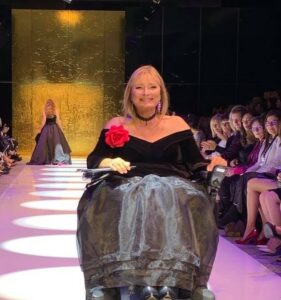
“I may be on wheels but my fashion moves me forward”.
To learn more about Carol and her life and work, follow her on;
Website: http://meqdesigns.com.au/
Facebook: @meq.designs
Instagram:
@carol.taylor.artist
@meq.designs

